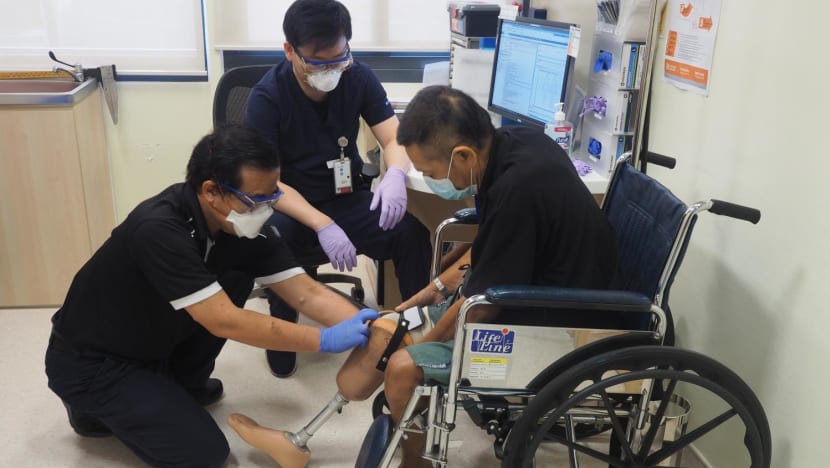Commentary: Losing a limb to diabetes is painful but not the end of the road
Singapore has one of the world’s highest proportion of diabetics in the world and this number is not set to ease anytime soon. One of the most visible and painful outcomes of this disease is when a patient has to lose a limb, say Tan Tock Seng Hospital’s experts.

Mr Shariff Abdullah participated in the Tenzig Hillary Everest marathon in 2016 even after he lost his left leg. (Source: Tan Tock Seng Hospital)
SINGAPORE: For many diabetic amputees, the fateful day may begin very much like any other - a bump against the door, a small blister from walking a little too long or an ill-fitting pair of new shoes.
This unexpected occurrence soon leads to a fever, swelling and pain that won’t go away or a wound that refuses to heal. And before the patient knows it, his doctor has bad news: The limb must be amputated.
In Singapore, diabetes mellitus is on the rise. From 2019 to 2020, the crude prevalence of diabetes was 9.5 per cent, an increase from 8.8 per cent in 2017 (despite a five-year “War on Diabetes”).
According to the International Diabetes Federation’s 2021 report, Singapore continues to have a high prevalence of diabetes mellitus at 11.6 per cent, compared to the global average of 9.8 per cent, the American average of 10.7 per cent and Australian average of 6.4 per cent.
Commonly referred to as a “lifestyle disease”, diabetes can worsen if the patient doesn’t change their diet, doesn’t do regular exercise, has poor compliance with treatment or continues to smoke and drink. When the disease is not managed well, foot ulcers may develop and this can progress to lower limb amputations (defined as below knee or more proximal amputation).
Singapore has a fairly high rate of amputation – according to data, up to four lower limb amputations were done in a day between 2015 and 2016.
At Tan Tock Seng Hospital (TTSH), 80 per cent of our patients who need amputation have significant comorbidities – like high blood pressure or heart disease. Add to that, a significant proportion lack awareness about how damaging untreated foot ulcers can be.
In 2017, TTSH had about 90 major lower limb amputations. Thankfully though, the incidence of lower limb amputation is coming down with early intervention by vascular surgery and a multi-disciplinary approach.
Amputation is a last resort accepted only when life is at stake or when a prolonged course of conservative treatments fails. It is never easy to agree on amputation even if it is to save lives, because life after an amputation can be daunting.
DAUNTING PROSPECT OF LIFE AFTER LOSING A LIMB
The surgical removal of a limb and its impact can be devastating news. The announcement strikes fear in every patient – fear of pain and suffering and of uncertainty over what the future may hold.
Questions on the social front hit especially hard: Will I be able to hold a job? How will I support my family? What will happen to my housing mortgage and other loans on top of paying all these medical bills?
But unlike the old days, patients today have better outcomes to look forward to. As in most public hospitals in Singapore, TTSH has a multi-disciplinary team which cares for amputees. This team comprises therapists, prosthetists, podiatrists, social workers and specialty nurses working with the doctors.
Importantly, volunteers from the Amputee Support Group (ASG), of whom many are amputee patients themselves, will connect with the patients and their caregivers.
Once a patient has completed surgery, the team takes over and the first stop is to educate them about their rehabilitation journey.
They are given information on how they can walk with the help of a prosthesis, the choice and cost of prosthesis fabrication, the duration required to be trained to walk and how to be independent again – all these help patients find hope and courage to face life after amputation.
It is important that the patients and their families hear from both the healthcare providers and ex-patients to get a sense on how the rehabilitation journey will look like.
In the last 10 years, more financial assistance has been introduced and available for patients who require prosthetics, mobility devices and help in their homes. The priority is for patients to be fitted with prosthesis and enable them to walk again.
Any delay in obtaining prosthesis can delay their rehabilitation treatment and lead to increase in anxiety and depression. An expanded list of subsidised prosthetics with more financial assistance options also help our patients get to work quicker.
BACK TO FULL LIVES - EVEN WORK AND SPORTS
One little known part of the work we do is that patients can eventually go on to live full lives – they can resume work and even take part in sports.

Our team of doctors, physiotherapists, occupational therapists, prosthetists and medical social workers work to set out customised treatment goals. A patient who wishes to return to adaptive sports such as bowling will be prescribed suitable prosthesis.
Another patient who wishes to return to driving after an amputation will also be recommended treatment programmes to help him achieve this. For some, this is also their livelihoods and it is important they get back to being able to work when possible.
A multi-disciplinary approach is needed to help amputees who desire to return to work access their options, perform job specific training on top of gait training and job counseling. Collaboration between hospital practitioners and community partners (e.g. ABLE in Toa Payoh) as well as befriending support from ASG can help in this aspect.
We find that patients benefit greatly from the ASG. Launched in 2010, its active members are trained to be befrienders giving advice to amputee patients. ASG programmes have reached out to more than 200 patients, family members and caregivers of amputees.
While we may see lesser amputations from better care of diabetes mellitus and advances in revascularisation surgeries (an operation to open up blocked blood vessels), diabetic amputation remains a challenge in Singapore as our amputees are often older, and they are at risk of further amputations after the first amputation.
But better public awareness on the plight of this group of patients, early intervention and support for their care and inclusion in the society can further improve the quality of life for them.
Tess Hng is a Principal Medical Social Worker at Tan Tock Seng Hospital and Dr Tjan Soon Yin is a Senior Consultant of the Department of Rehabilitation Medicine at TTSH.




















